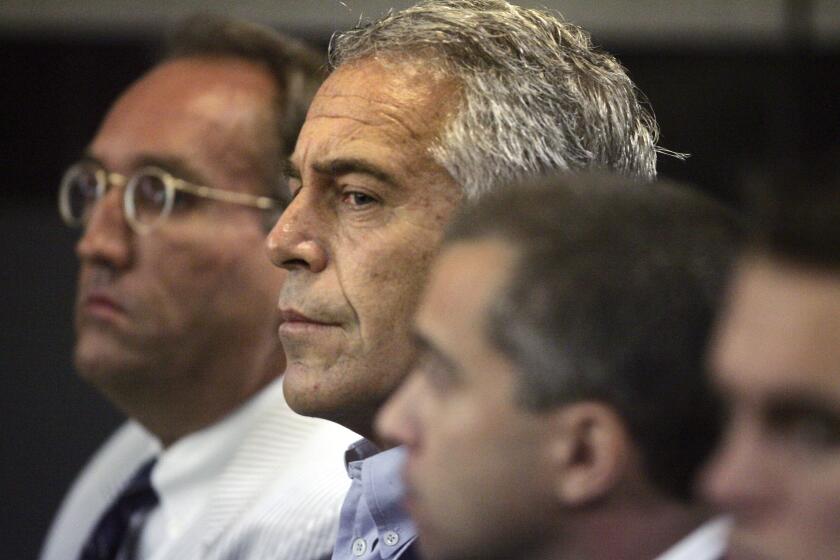Afghan Alliance Banking on New Airstrip
- Share via
SHIRKAT, Afghanistan — Opposition forces have almost finished building a new runway in the desert north of Afghanistan’s capital, Kabul, that military experts say will open an air bridge for foreign weapons and could set the stage for an all-out ground offensive against the Taliban regime.
U.S. forces are already operating in Afghanistan without a staging area such as the Shirkat airstrip, which is long enough to handle U.S. military transports if the Pentagon decided to land troops there, said Ian Kemp, news editor for the respected Jane’s Defense Weekly.
Just hours before Washington put Army Rangers on the ground in the country, Afghan construction workers were laying gravel on an airstrip about half a mile long next to a former Soviet military base here.
Once complete in the coming days, the runway will make it much easier for Russia to deliver on a promise to fly in large amounts of weapons and ammunition, Kemp said in a telephone interview from London.
Russia has been supplying the anti-Taliban Northern Alliance with arms and weaponry since 1996. When President Vladimir V. Putin announced in September that Russia would assist the U.S.-led operation in Afghanistan, he also pledged that Moscow would boost arms deliveries to the Northern Alliance.
The plan to provide a steady arms supply to the Northern Alliance is “being done with the full cooperation and knowledge of the U.S. government,” Kemp said.
In fact, Russia expects Washington to help pay for the increased weaponry. “We would not mind,” Russian Foreign Minister Igor S. Ivanov said recently, “if other countries concerned, whose number has been growing of late, would render material assistance to us in this respect.”
“The Russians are talking now about providing big quantities of equipment,” Kemp said. “There are suggestions of 40 or 50 tanks, 80 or so other armored vehicles and huge quantities of arms and ammunition.”
Kemp said the tanks would probably have to arrive by a different route but that they alone wouldn’t necessarily tilt the military balance decisively in the Northern Alliance’s favor because the Taliban has had overwhelming superiority in heavy armor for years but failed to wipe out the alliance. An important difference now, however, is that U.S. air power is targeting Taliban tanks and artillery.
Few Details on How Airstrip Will Be Used
The Northern Alliance has made no secret of the fact that it expects large amounts of Russian military aid to begin arriving soon, but it is still reluctant to detail how the new runway will be used.
In light of Washington and Moscow’s close cooperation in the war against terrorism and the Taliban, the Pentagon could use Russian transports to supply the Northern Alliance with sophisticated equipment such as scrambled field radios, said Peter Feldstead, another Jane’s editor.
“We’re getting reports that they are being provided with secure communications by the Americans,” said Feldstead, who edits the Jane’s Web site. “That adds a significant capability. Instead of the Taliban being able to listen in on their every word, they’ll be able to plan their attack and execute it without the Taliban knowing what’s going on.”
Afghans prefer to fight with Russian arms and equipment because they are compatible with those they inherited after Soviet forces withdrew in defeat in 1989.
“The Northern Alliance only loves Soviet-made weapons,” Ivanov said last month in Brussels after discussing the matter with North Atlantic Treaty Organization officials. “It knows how to handle them and says it doesn’t need any other weapons, even more modern Russian ones.”
“If you take tanks, then the Northern Alliance needs T-55s, which have been in Afghanistan for 20 years,” Ivanov said. “For the Afghans, there has never been anything more reliable than the Kalashnikov.”
Foreign aid workers who fight a daily battle to get medical equipment, medication and other relief supplies into Northern Alliance territory along rough mountain roads suggested in the spring of 2000 that an airstrip should be built.
But the alliance said the Shirkat area was too dangerous because it is well within range of front-line Taliban artillery and rockets, said Dr. Gino Strada, an Italian surgeon who heads Emergency, a Milan-based charity that treats Afghans wounded in battle or by land mines.
The decision to build the runway now, when the Taliban’s front lines north of Kabul are heavily fortified, suggests that the alliance may plan to launch an offensive to push Taliban forces south so they can’t threaten the planes flying in weapons and ammunition.
“My feeling is that if they want to have this airstrip operational, they have to clear 10 to 15 kilometers [six to nine miles] around it from Taliban antiaircraft guns and such to have a safe landing place,” Strada said.
Strada said he thinks that the Shirkat runway may be used to land foreign soldiers. “All I can say for sure is that you don’t take Kabul by shouting bowwow to the Talibs,” he said.
The Pentagon has been making daily broadcasts to Afghans from U.S. Air Force planes.
“Attention, people of Afghanistan!” says one message, according to an official Pentagon transcript. “United States forces will be moving through your area. We are not here to harm you! We are here for Osama bin Laden, Al Qaeda and those who protect them!
“Please, for your own safety, stay off bridges and roadways, and do not interfere with our troops or military operations.”
But Kemp said it is unlikely that U.S. forces would use the Shirkat airstrip because they would probably fly in on tactical helicopters from staging areas to the north of Afghanistan.
“I couldn’t see why they would want transport aircraft there,” he said, “but of course, not being privy to what is actually going to unfold, it is difficult to say.”
If the war escalates and Pentagon planners decide they need the Shirkat runway, missions in the former Yugoslav federation have proven that U.S. troops can quickly rebuild runways and set up air traffic control and other infrastructure at airports that have none, Kemp said.
The new airstrip here runs roughly east to west next to the Darband mountains. Local villagers say that work on the runway began about two weeks ago and that it will be about half a mile long when finished.
It would have to be twice that length to handle the largest Russian Antonov-70 transport planes capable of delivering heavy armor such as tanks, Kemp said.
But smaller Antonov-24 and Antonov-26 aircraft loaded with ammunition from bullets to artillery shells and Katyusha rockets--staples of Afghan warfare--could easily land on the gravel-and-sand strip, Feldstead said.
Soldiers guarding the construction Friday said the moujahedeen fighters in charge of the project are living in a tent pitched next to the runway, where a bulldozer and other heavy road equipment were at work.
No visits with the fighters were allowed without the approval of Gen. Bismillah Khan, second in command to alliance chief Gen. Mohammed Fahim. Khan could not be reached for comment.
The alliance’s troops in the region have long had logistical problems because, as the Taliban advanced north in recent years and seized strategic towns and cities, such as Mazar-i-Sharif, it was able to cut off the best supply routes.
With winter about to arrive, the Northern Alliance will have even more trouble getting weapons and ammunition to the fronts closest to Kabul unless they come by air, and the few helicopters it has aren’t big enough to transport large amounts of materiel.
The closest existing airport is the Soviet-built Bagram air base, where the Northern Alliance says the Taliban is dug in so close at some points that enemy soldiers can shout at each other across the front line.
*
Times staff writer Maura Reynolds in Moscow contributed to this report.
More to Read
Sign up for Essential California
The most important California stories and recommendations in your inbox every morning.
You may occasionally receive promotional content from the Los Angeles Times.












